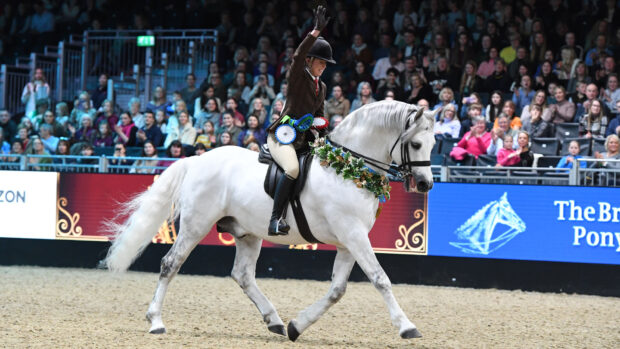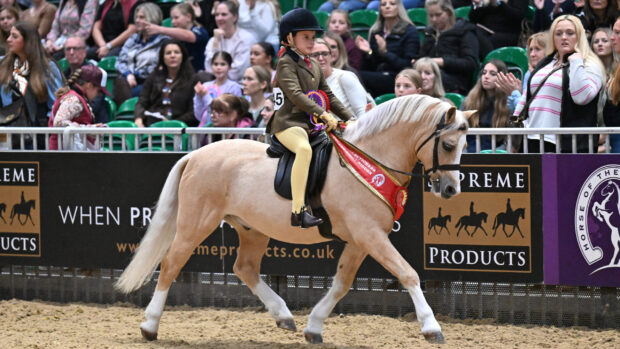Fell ponies are native to the North of England, and are mostly found in Cumbria. Herds of registered ponies still run on the Cumbrian fells, playing an important role in maintaining the Fell pony characteristic of hardiness.
The Fell is an ideal all-round family pony for adults and children as well as a popular show animal. They cannot exceed 14hh in height and while there is no lower height limit, there are very few under 12.2hh.
The Fell Pony Society (FPS) provides the following breed standard:
Head: Small, well chiselled in outline, well set on, forehead broad, tapering to nose.
Nostrils: Large and expanding.
Eyes: Prominent, bright, mild and intelligent.
Ears: Neatly set, well formed and small.
Throat and jaw: Fine, showing no signs of throatiness nor coarseness.
Neck: Of proportionate length, giving good length of rein, strong and not too heavy, moderate crest in case of stallion.
Shoulders: Most important, well laid back and sloping, not too fine at withers, nor loaded at the points — a good long shoulder blade, muscles well developed.
Carcase: Good strong back of good outline, muscular loins, deep carcase, thick through heart, round ribbed from shoulders to flank, short and well coupled, hind quarters square and strong with tail well set on.
Feet, legs and joints: Feet of good size, round and well formed, open at heels with the characteristic blue horn, fair sloping pasterns not too long, forelegs should be straight, well placed not tied at elbows, big well formed knees, short cannon bone, plenty of good flat bone below knee (eight inches at least), great muscularity of arm.
Hind leg: Good thighs and second thighs, very muscular, hocks well let down and clean cut, plenty of bone below joint, hocks should not be sickle nor cow-hocked.
Mane, tail and feather: Plenty of fine hair at heels (coarse hair objectionable), all the fine hair except that at point of heel may be cast in summer. Mane and tail are left to grow long. Ponies should be shown with untrimmed manes.
Action: Walk, smart and true. Trot well balanced all round, with good knee and hock action, going well from the shoulder and flexing the hocks, not going too wide nor near behind. Should show great pace and endurance, bringing the hind legs well under the body when going.
The Fell can be black, brown, bay and grey in colour. Chestnuts, piebalds and skewbalds are debarred. A star and/or a little white on or below the hind fetlock is acceptable. An excess of white markings is discouraged, but such ponies are eligible for registration. The FPS reports that more than half the breed population has no white markings.
According to the FPS, Fells are most commonly found in the old counties of Cumberland and Westmorland, where they are believed to have roamed since pre-historic times:
“The animals in use were kept handy in the villages, and the breeding stock lived out on the fell. From the 11th and 12th centuries ponies were being used for longer distance pack work carrying loads of fleeces, woollen goods, foodstuff such as cheeses, meat, fish and preserves, and local metal ores. They were used for shepherding and to hunt wolves that might attack the flocks on the sheepwalks.”
“By the 13th century there was a brisk trade in wool to Belgium, and ponies were used to transport merchandise all around the country. Pack trains were well organised and made regular journeys. For instance, in the winter of 1492-93, 11 Kendal traders made a total of 14 journeys to Southampton with pack horses carrying loads of cloth.
“Fell Ponies, known locally as ‘galloways’ , were also used for the Cumberland sport of trotting races. Fell ponies were used by big Northeastern collieries such as Ashington until well into the 20th century.
Breeders began to record pedigrees of their stock towards the end of the 19th century. In 1922, the FPS was set up in its present form. Its purpose was not to improve but to “keep pure the old breed of pony” in the face of cross breeding to produce farm horses and showy road animals such as the Wilson pony.
Today, the Fell is used as for various jobs. They are popular all-rounders, driving ponies and working hunter ponies. They are extremely versatile and can excel in performance roles but their sure footedness can mean they are hardier and lower maintenance than some breeds.
To test these qualities of the breed, the society holds an annual performance trial. According to the FPS: “Fell Ponies are generally creditable jumpers, particularly across country, being both agile and clever on their feet. Their abilities are well up to working hunter pony competitions and Pony Club events.”
Fells are also seen in endurance riding or in hacking roles.
Fell pony showing classes at local, national and championship level are also never short of entries. 2019 will be the first year the breed will have their own final at the Horse of the Year Show (HOYS). The winner of the 2018 Fell and Dales final was Lucinda Stockley and her own stallion Murthwaite Oliver.
Also in 2018, the overall winner of the M&M pony of the year championship was Gwen Rae’s black stallion Greenholme Emblem and his producer Kirsty Aird.
Article continues below…
You might also be interested in:

The New Forest pony: the ideal performance native pony
Find out more about this native breed, which has an unusual history

Subscribe to Horse & Hound magazine today – and enjoy unlimited website access all year round
Two Fells have won the prestigious Olympia M&M ridden final; In 1992, Lunesdale Lucky Lady and Lizzie Briant were the victors, while in 2015, it was the turn of Rebecca Penny on her own stallion Townend Schubert.
HM the Queen breeds Fells under her Balmoral prefix. Some of her ponies are sometimes used for carrying the stags and grouse panniers down from the moors at Balmoral while others are used for both riding and driving by the Royal Family.




